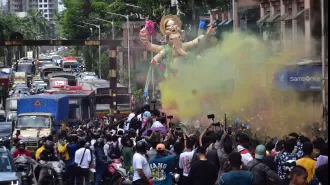Gillespie Golf Course celebrates the Greensboro Six's impact.
In 1955, the Greensboro Six, led by Dr. George Simkins, broke racial barriers by playing at the previously whites-only Gillespie Golf Course.
June 21st 2024.

Golf is not just a leisurely activity for some to enjoy on a sunny day. In fact, it represents a major industry in the United States, with a value of over $84 billion in 2022. However, despite the millions of recreational golfers in the country, less than 3% of them are Black. But recent research has revealed that this statistic, just like the history of the game itself, is misleading and incomplete.
The roots of golf are deeply intertwined with the tactics and beliefs of white supremacy. Take, for example, the prestigious Augusta National, home of the Masters Tournament. This course was built on a foundation of segregation and supremacy, with its founder, Clifford Roberts, boldly stating that it would remain a whites-only space as long as he was alive. These discriminatory practices were not limited to just one golf course, but rather permeated the entire industry.
In a beautiful and meaningful tribute to the fight against segregation, Wyndham Rewards has teamed up with the City of Greensboro and First Tee–Central Carolina to commission artist Vincent Ballentine to create a commemorative mural at the historic Gillespie Golf Course. Ballentine, a multi-talented artist from Brooklyn, New York, has a deep understanding of the power of art and its ability to capture history. He holds a degree in film and education and has continued his studies in film at the renowned Cleveland Institute of Art.
This project serves as a powerful reminder of the courageous actions of the Greensboro Six, a group of civil rights pioneers who made history in 1955 by playing at the then whites-only Gillespie Golf Course. Their bravery and impact paved the way for desegregation and opened doors for future generations. BLACK ENTERPRISE had the opportunity to sit down with Ballentine, Chris Simkins (son of Dr. George Simkins Jr., one of the Greensboro Six), and Ryan Wilson (president of First Tee Carolina) to discuss the significance of this mural and the impact it will have on the city of Greensboro and beyond.
The Greensboro Six's actions not only challenged the status quo in the world of golf but also paved the way for integration in other major American sports leagues. The PGA, for instance, had a rule specifically prohibiting Black players from participating, and it was not until 1961, a decade after other leagues had integrated, that this rule was finally abolished. The mural serves as a symbol of the bravery and determination of these individuals, and it is a powerful reminder that the fight for justice and equality is ongoing.
Ballentine's mural is not just a historical representation but an artistic fusion of movement and history. He wanted to capture the essence of golf, which is not just about hitting a ball, but also about the movements of the body. This is especially significant when considering the vital role that free and enslaved Black Americans played in designing and maintaining golf courses in the 18th and 19th centuries, despite being barred from playing on them.
Gillespie Golf Course continues to honor the legacy of the Greensboro Six by providing opportunities for local youth through First Tee–Central Carolina. The course also hosts PGA HOPE, which offers programs for veterans and players with disabilities. Ballentine hopes that this mural will serve as a symbol of progress and inspire future generations to continue the fight for inclusivity and unity.
The mural, set to be unveiled on August 5, just before the 85th Annual Wyndham Championship, will be a lasting tribute to the Greensboro Six. It is a testament to the power of art and its ability to capture and preserve history. As Ryan Wilson points out, this mural will serve as a reminder for generations to come that many have endured similar circumstances at golf courses worldwide, but that progress and change are possible.
The mural at Gillespie Golf Course is not just a piece of art, but a beacon of hope and a reminder of the progress that has been made thanks to the bravery and determination of heroes like the Greensboro Six. As Chris Simkins poignantly states, it is a tribute to the progress that has been made and a reminder of the work that still needs to be done. This mural will stand as a powerful symbol of resilience and progress, inspiring us to continue the journey towards a more inclusive and unified world.
The roots of golf are deeply intertwined with the tactics and beliefs of white supremacy. Take, for example, the prestigious Augusta National, home of the Masters Tournament. This course was built on a foundation of segregation and supremacy, with its founder, Clifford Roberts, boldly stating that it would remain a whites-only space as long as he was alive. These discriminatory practices were not limited to just one golf course, but rather permeated the entire industry.
In a beautiful and meaningful tribute to the fight against segregation, Wyndham Rewards has teamed up with the City of Greensboro and First Tee–Central Carolina to commission artist Vincent Ballentine to create a commemorative mural at the historic Gillespie Golf Course. Ballentine, a multi-talented artist from Brooklyn, New York, has a deep understanding of the power of art and its ability to capture history. He holds a degree in film and education and has continued his studies in film at the renowned Cleveland Institute of Art.
This project serves as a powerful reminder of the courageous actions of the Greensboro Six, a group of civil rights pioneers who made history in 1955 by playing at the then whites-only Gillespie Golf Course. Their bravery and impact paved the way for desegregation and opened doors for future generations. BLACK ENTERPRISE had the opportunity to sit down with Ballentine, Chris Simkins (son of Dr. George Simkins Jr., one of the Greensboro Six), and Ryan Wilson (president of First Tee Carolina) to discuss the significance of this mural and the impact it will have on the city of Greensboro and beyond.
The Greensboro Six's actions not only challenged the status quo in the world of golf but also paved the way for integration in other major American sports leagues. The PGA, for instance, had a rule specifically prohibiting Black players from participating, and it was not until 1961, a decade after other leagues had integrated, that this rule was finally abolished. The mural serves as a symbol of the bravery and determination of these individuals, and it is a powerful reminder that the fight for justice and equality is ongoing.
Ballentine's mural is not just a historical representation but an artistic fusion of movement and history. He wanted to capture the essence of golf, which is not just about hitting a ball, but also about the movements of the body. This is especially significant when considering the vital role that free and enslaved Black Americans played in designing and maintaining golf courses in the 18th and 19th centuries, despite being barred from playing on them.
Gillespie Golf Course continues to honor the legacy of the Greensboro Six by providing opportunities for local youth through First Tee–Central Carolina. The course also hosts PGA HOPE, which offers programs for veterans and players with disabilities. Ballentine hopes that this mural will serve as a symbol of progress and inspire future generations to continue the fight for inclusivity and unity.
The mural, set to be unveiled on August 5, just before the 85th Annual Wyndham Championship, will be a lasting tribute to the Greensboro Six. It is a testament to the power of art and its ability to capture and preserve history. As Ryan Wilson points out, this mural will serve as a reminder for generations to come that many have endured similar circumstances at golf courses worldwide, but that progress and change are possible.
The mural at Gillespie Golf Course is not just a piece of art, but a beacon of hope and a reminder of the progress that has been made thanks to the bravery and determination of heroes like the Greensboro Six. As Chris Simkins poignantly states, it is a tribute to the progress that has been made and a reminder of the work that still needs to be done. This mural will stand as a powerful symbol of resilience and progress, inspiring us to continue the journey towards a more inclusive and unified world.
[This article has been trending online recently and has been generated with AI. Your feed is customized.]
[Generative AI is experimental.]
0
0
Submit Comment





